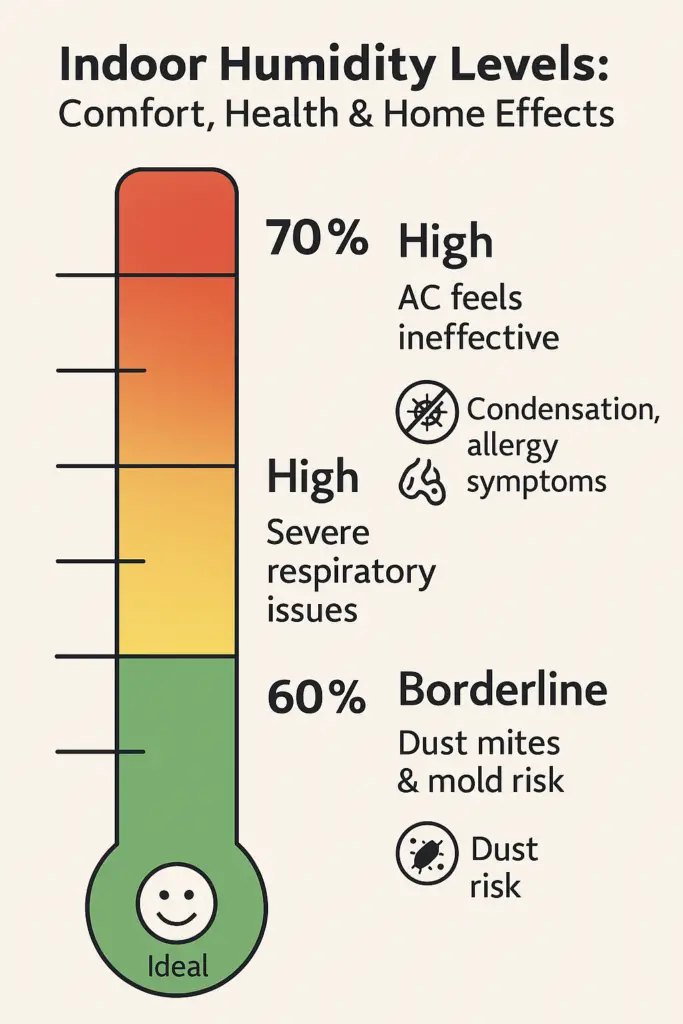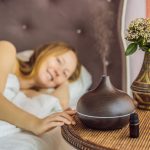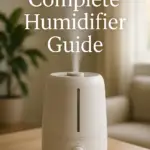Humidity affects your comfort, your health, and even the lifespan of your home’s materials. Below is a quick visual showing the differences between 60%, 70%, and 80% humidity indoors, followed by a breakdown of what each level means and how to fix it.

This article is about many of the symptoms and problems that you can expect with high humidity. And some solutions too.
40 to 60% relative humidity is the optimal range to protect your home and family from the spread of germs and avoid damage to your personal property.
A direct statement by ncbi.nlm.nih.gov
says “health effects caused by road of humidity would be minimized by maintaining indoor levels between 40 and 60%”
| Humidity Level | Symptoms |
|---|---|
| 60% | Nearing discomfort range, potential for mold growth, increased allergens like dust mites. |
| 70% | AC inefficiency, visible condensation, clammy skin, frizzy hair, sneezing, itchy eyes, increased mold and mildew growth. |
| 80% | Wheezing due to dust mites and mold spores, risk of dehydration, reduced physical performance, wood rot, damage to musical instruments, proliferation of fungi and bacteria. |
Table of Contents
Humidity 60 in the House
At 60%, the humidity in the house is nearing the outside of the range of what is considered comfortable and safe humidity inside of the home.
At 60% RH, you have already begun to enter into an area of relative humidity that can provide enough moisture in the air for mold to take root.
As that number increases, the likelihood of mold being found somewhere in your home increases.
The risk of mold growth increases significantly as humidity levels rise above 60%. And with mold comes mold spores. A significant household allergen.
70 humidity in house
At 70%, you are already noticing the telltale signs all around you.
The AC will begin to feel like it’s not running at all and condensation will be nearly pouring from it.
You will undoubtedly feel very clammy and will have no chance of dealing with your frizzy hair.
You might also find yourself sneezing and rubbing your itchy eyes.
Why is that?
It’s because dust mites thrive in temperatures that hover around the 70 to 80° range with a relative humidity of 70 to 80%.
In addition to the discomfort and presence of dust mites, high humidity levels like 70% can lead to other significant issues within your home.
The excessive moisture creates an ideal environment for the growth of mold and mildew, which can cause damage to your home’s structure and furnishings.
More importantly, mold and mildew release spores into the air, contributing to indoor air pollution and potentially leading to health problems such as respiratory issues, allergies, and asthma in susceptible individuals.
80 humidity in house
At 80% humidity, you may start wheezing because of the amount of dust mites and mold spores in the air.
And the risk of dehydration will become a real threat because your body will not be able to produce sweat nearly as easily at that level.
Your performance will be off and you will find that you’re not able to do as much without getting tired.
Humidity sustained at that level will begin to rot the wood around your home including window sills and floorboards.
And any musical instruments you have around the house will have probably gone way out of tune by now. And the risk of them bowing to a point that they may never play well again is serious.
Moreover, the pervasive dampness associated with 80% indoor humidity can lead to a proliferation of other allergens, such as fungi and bacteria, further compromising indoor air quality.
This environment not only exacerbates existing respiratory conditions but can also trigger new health issues among the home’s inhabitants.
Electronic devices and appliances are not immune to the ravages of high humidity either; the excessive moisture can corrode circuits and internal components, leading to malfunctions and a shortened lifespan for these items.

Uhh!!
As you can tell, a sustained high level of humidity is not good for your health or your home. If any of this describes your situation then you should be taking steps to remedy the situation.
Determine the Origin of the Humidity
Climate
Of course there’s not too much you can do about the weather. And if the outside humidity is shooting up then you’re inside humidity is going to shoot up with it.
Here’s a Few Solutions:
Air Conditioning
Refrigerated air conditioners, either the type you have built into your house via the HVAC or window air conditioners which would include portable air conditioners that vent out of the window, will reduce the humidity inside of the house.
This type of air conditioner pulls humidity out of the air, reduces it to condensation, and either drips or funnels it outside.
And most refrigerated ACs you find these days have a dehumidifier setting that will reduce the humidity in the room without having to have the cool function running. The dehumidifier setting on an AC is usually called “dry mode”. It’s symbolized by a water drop, if your unit has symbols instead of words.
Dehumidifier
The dehumidifier is a device that is similar to a refrigerator air conditioner except that it doesn’t have any type of cool setting.
It’s only function is to reduce the humidity.
Humidifiers exhaust heat similar to the way a window air conditioner does.If you have ever walked behind a window air conditioner then you probably remember feeling heat coming off of the unit.
But the heat that is exhausted on a dehumidifier is expelled inside of the room.
A factor you’ll want to consider when you’re thinking about operating a dehumidifier. Depending on the reason for the humidity, the heat exhausting from the machine it’s not exactly a welcomed feature if the temperature is already hot outside.

When is the AC not useful in humidity?
Even though refrigerator air conditioning is the easiest and most effective way to bring them the humidity level indoors, there are times when air conditioning will do the opposite.
AC humidity problems
1. Running the AC with “fan on” setting engaged.
There’s a lot of confusion when it comes to running the air conditioner with the “fan on” setting engaged versus the “auto on” setting engaged.
The “fan on” setting well actually makes your home feel more humid.
The reason is, one of the primary ways that an air conditioner cools down a room is by extracting the humidity and turning it into condensation.
But when the “fan on” setting is engaged, the humid air that is being pulled into the air conditioner does not have a chance to stay in front of the condenser coils of the AC long enough to turn into condensation.
So the result is humid air being pulled into your air conditioner and redistributed throughout the house without the humidity being extracted.
2. Too Large of an Air Conditioner
Another problem that can occur with air conditioning and humidity is that you have too large of an AC unit.
The result of running an AC unit that is too large for a home is a phenomenon called “short cycling”.
Which means that your air conditioner turns on and off more frequently.
This affects the way a air conditioner extracts humidity because the air conditioner is continually turning on and off,
and not giving the condenser coils enough time to turn the humidity into condensation and funneled out of the house.
 3. Evaporative cooling
3. Evaporative cooling
Evaporative coolers are essentially a large fan blowing over water as a means of cooling the air off.
Evaporative coolers are also known as swamp coolers because they can make a room feel swampy.
Number one, if you were trying to use a evaporative cooler when the humidity is high, you will not be able to feel anything much more than a fan coming from the unit at that point.
Number two, you are only adding more humidity to an already elevated moisture level.
And for some people this may be the reason your home feels humid in the first place.
Any devices or machines like evaporative coolers or humidifiers that disburse water droplets into the air, should not be operated when the humidity level is high in the house.
Leaking pipes
If you have above average humidity in your home but the climate outside is not especially humid, then you have another problem altogether.
Basements are usually known to be extra humid because of being located beneath the ground.
The moisture in the ground can find itself inside of your home.
Dehumidifiers can be outfitted with pumps and drainage hoses to reduce the humidity inside of a basement.
Leaking water pipes are also found in the basement quite often and can cause the humidity level to soar.
Telltale sons of leaking pipes inside of your home usually appear as drywall that is bowing or that feels damp to the touch.
Discoloration of the walls usually indicates a leak of some sort also.
Leaks in the ceiling are usually very easy to locate and are very noticeable because they appear as some liquid that has been spilled on the ceiling.
If the high humidity inside of the home is due to leaking pipes, then as you probably guessed, you’re going to need a plumber.






